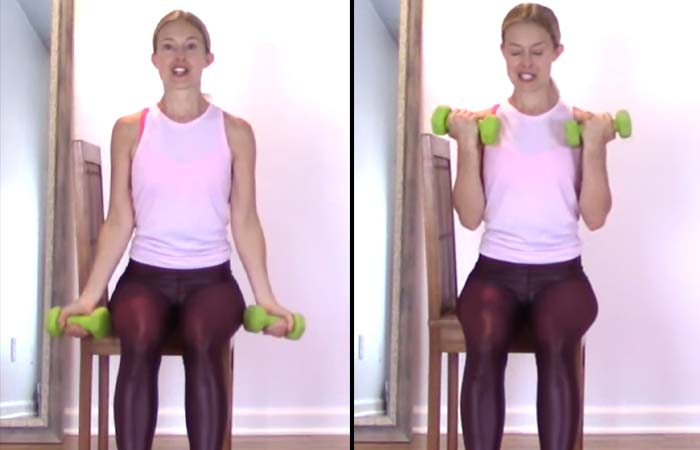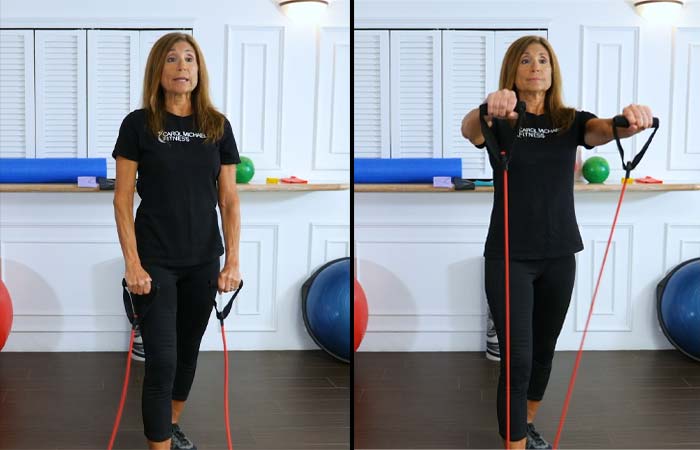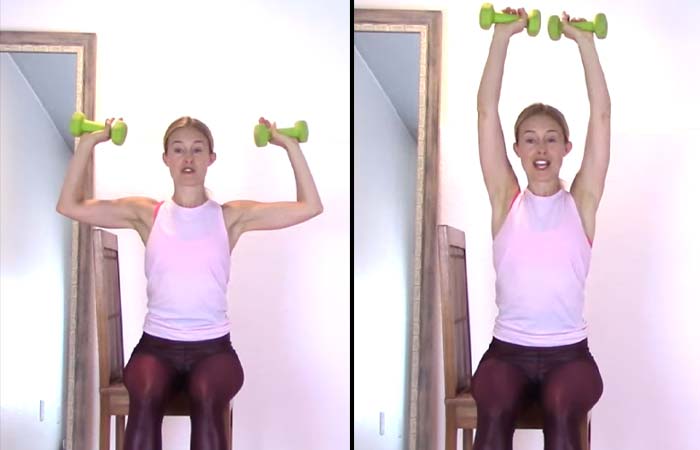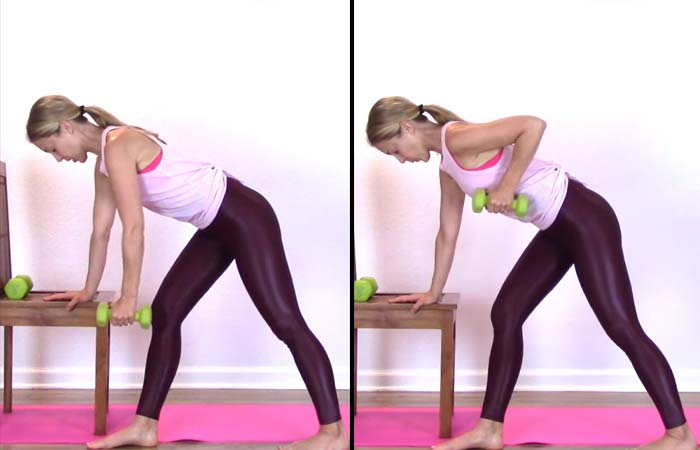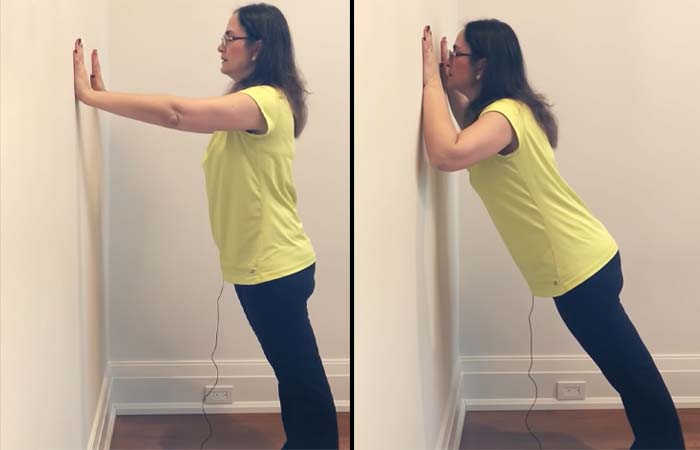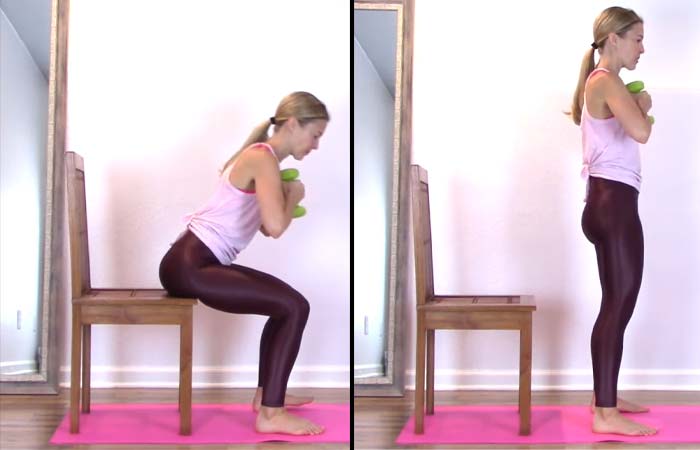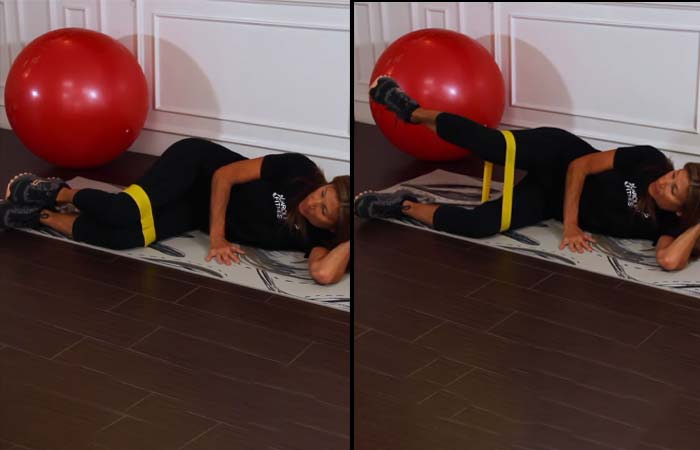Loss of bone density or osteoporosis affects over 200 million people globally. It increases fracture risk in women over 55 years and men over 65 years and affects the quality of life (1), (2). Thankfully, weight-bearing exercises can help strengthen the bones and prevent the loss of bone tissues. Here are 10 no-impact and low-impact full-body weight training exercises you can do safely for strong bones. Scroll down!
What You Need
- Light dumbbells (2 lbs)
- Resistance band
- A sturdy chair
- A yoga mat
Note: Talk to your doctor before doing these exercises.
10 Best Weight-Bearing Exercises For Osteoporosis
1. Seated Bicep Curls With Dumbbells
How To Do
- Grab a 2 lbs dumbbell in each hand.
- Sit on a chair with your feet and knees hip-width apart, elbows pressed to the body, hands down, and palms facing up. Roll the shoulders back, chin up, and look straight.
- Exhale, bend your elbows, and raise your hands till the shoulder level.
- Pause for a moment, inhale, and lower your hands.
- Do 3 sets of 8 reps.
2. Arm Raises With Resistance Band
How To Do
- Grab a tube resistance band.
- Anchor the band with your right foot, keep your hands down, roll the shoulders back, and look straight. This is the starting position.
- Exhale and raise your hands until the shoulder level.
- Inhale and lower your hands down.
- Do 3 sets of 8-12 reps.
3. Seated Dumbbell Shoulder Press
How To Do
- Grab 2 lbs dumbbells.
- Sit on a chair with your feet and knees hip-width apart.
- Raise your hands laterally up. Bend your elbows so that the forearms are perpendicular to the upper arms. Turn the wrists outward, roll the shoulders back, chin up, and look straight. This is the starting position.
- Inhale and slowly push both your arms above your head, bringing the heads of the dumbbells together.
- Pause for a moment, exhale, and lower your arms to the starting position.
- Do 3 sets of 8 reps.
4. Supported Bent Over Row
How To Do
- Grab a light dumbbell with your right hand.
- Bend forward, place the left palm on the seat of the chair, and extend the right hand towards the floor.
- Take a step back with your right leg, keep the knees soft, align the neck and back, and look down. This is the starting position.
- Exhale, bend your elbow, and pull the right hand towards the side of your bust. Squeeze your shoulder blades.
- Inhale and lower your hand to the starting position slowly.
- Do this 8 times before switching hands.
- Do 3 sets of 8 reps for each hand.
5. Best Over Fly
How To Do
- Grab a dumbbell in each hand.
- Stand with your feet hip-width apart and soften the knees.
- Bend forward from the waist, extend your hands, open your chest, and look at the dumbbells. This is the starting position.
- Exhale, raise your hands laterally up, and squeeze the shoulder blades.
- Inhale and bring the hands down.
- Do 3 sets of 8 reps.
6. Bodyweight Wall Push-Ups
How To Do
- Standing 2 feet away from a wall.
- Place your palms on the wall at shoulder level. This is the starting position.
- Bend the elbows and bring your chin closer to the wall.
- Pause for a moment and get back to the starting position.
- Do 3 sets of 10 reps.
7. Chair Squats
How To Do
- Grab a light dumbbell in each hand. Join them, emulating a “namaste”. Keep the elbows and chin up, roll the shoulders back, and look straight.
- Sit on a chair with your feet flat on the floor and toes slightly pointing outward.
- Stand up slowly.
- Push your hips back, bend your knees, and sit down.
- You can ask for assistance if needed.
- Do 3 sets of 8 reps.
Note: Avoid this exercise if you have knee issues.
8. Reverse Lunge With Weighted Bicep Curl
How To Do
- Grab a light dumbbell in each hand, stand straight with your feet shoulder-width apart and hands by your side. Roll your shoulders back, keep your core tight, chin up, and look ahead.
- Take a step back with your right leg.
- Bend your knees to lower your body until the thighs and shins are perpendicular to each other.
- Simultaneously, bend your elbows and curl up your hands.
- Get back to the starting position.
- Repeat with the other leg to complete one rep.
- Do 3 sets of 8 reps.
9. Resistance Band Leg Press
How To Do
- Lie on your back on a mat.
- Anchor a flat resistance band with your feet.
- Press the knees against the chest with the elbows close to the sides. This is the starting position.
- Extend the legs at a 60-70° angle.
- Bend your knees and get back to the starting position.
- Do 3 sets of 10 reps.
10. Hip Strengthening
How To Do
- Wrap a loop resistance band above the knees.
- Lie on your right side and support your head with the right hand. Keep your knees bent so that the thighs are perpendicular to the shins. Place your left palm on the mat for support. This is the starting position.
- Lift your left leg, opening the hip and pelvic area.
- Bring it back to the starting position.
- Do this 8-10 times before switching sides.
- Do 3 sets of 8-10 reps.
These 10 exercises will help minimize the rate of bone loss due to osteoporosis, conserve the bone tissues, and lower the risk of fractures. But how often should you do them? Scroll down to find out.
How Often Should You Exercise?
Do these exercises 3-4 days a week, and no-impact or low-impact cardio like walking, yoga, or tai chi rest of the days. Remember, overdoing these exercises may cause injuries. Rest properly and let your muscles recover. However, there are certain exercises that you must avoid at all costs.
Which Exercises To Avoid
If you have osteoporosis, avoid:
- High-intensity exercises like sprints
- High-impact exercises that involve jumping like box jumps
- Exercises that involve twisting the spine
- Exercises that involve deep stretches
- Balance exercises without support or assistance from physical therapists
Exercising the right way is crucial for people with osteoporosis. Here are the precautions you should take.
Precautions To Take
- Always warm up for 10 minutes before exercising.
- If standing exercises are painful, sit on a chair or bench to do them.
- Irrespective of the need, always use a mat to prevent injury risk in case you lose balance.
- Always exercise in an open space.
- Wear comfortable shoes with a good grip.
Apart from exercising, there are a few other things you should do to ensure your bone health. Scroll down to find out.
What Else Can You Do To Strengthen The Bones?
- If you have osteoporosis, the doctor may prescribe calcium and vitamin D supplements. Take the dose as per the doctor’s recommendation.
- Consume organic foods instead of processed, frozen, or canned foods.
- Add a healthy dose of nuts, seeds, and fatty fish to your diet.
- Go on morning walks.
The Takeaway
Osteoporosis or age-related bone degeneration is common in men and women. Therefore. after 40, you must start taking care of your bone health. However, if you have been diagnosed with osteoporosis, talk to your doctor immediately and start doing weight-bearing exercises. This will help improve your bone strength and reduce your need to depend on a caretaker. Go ahead and do these 10 strength training exercises for osteoporosis and improve your quality of life.
Sources
Articles on StyleCraze are backed by verified information from peer-reviewed and academic research papers, reputed organizations, research institutions, and medical associations to ensure accuracy and relevance. Read our editorial policy to learn more.
The post Weight Training For Osteoporosis – 10 Exercises For Strong Bones appeared first on STYLECRAZE.
This content was originally published here.



